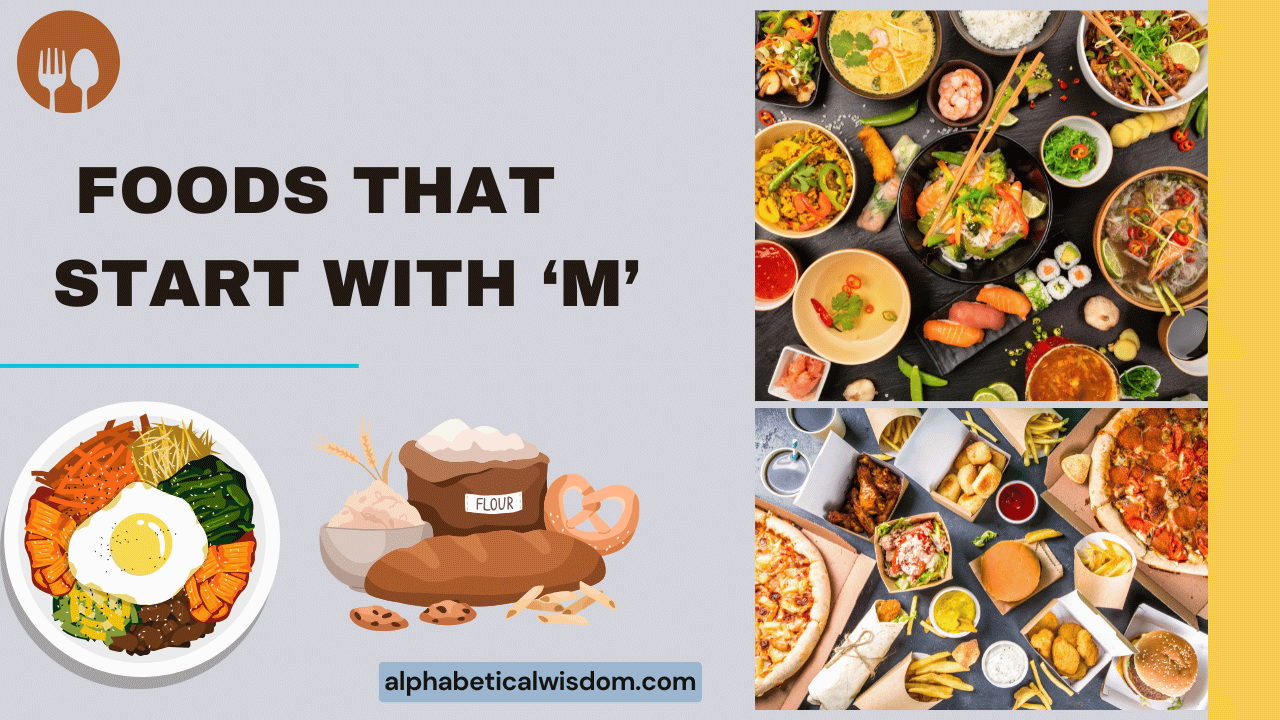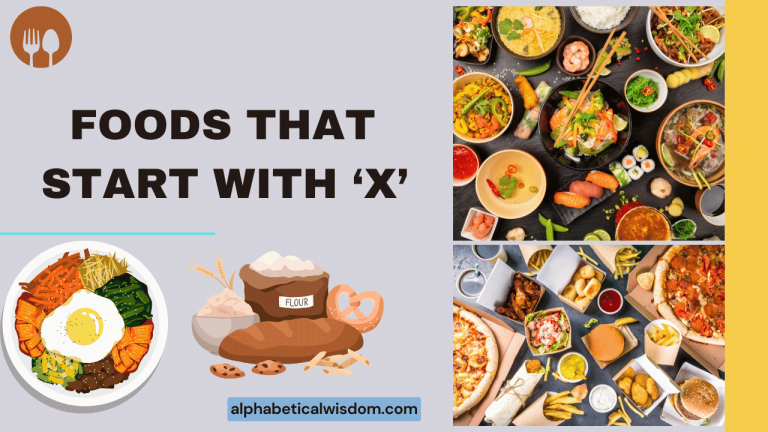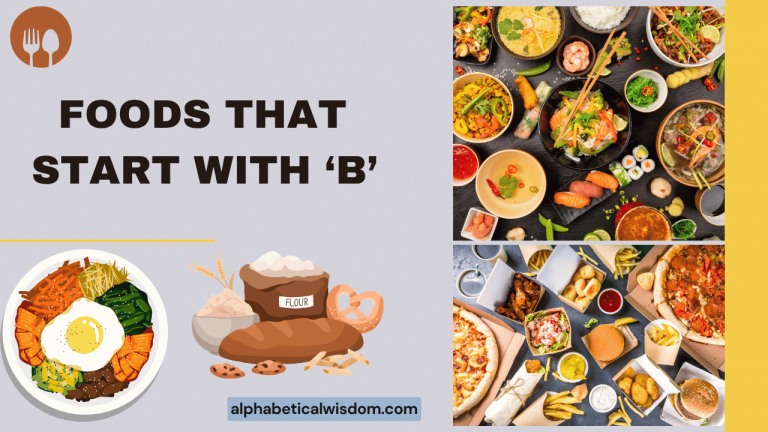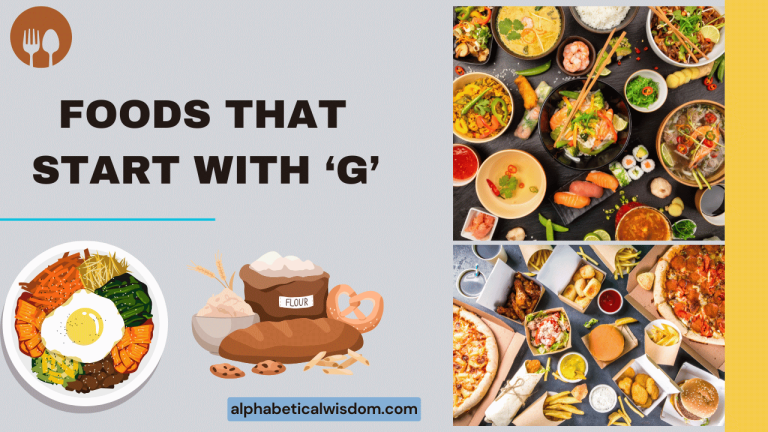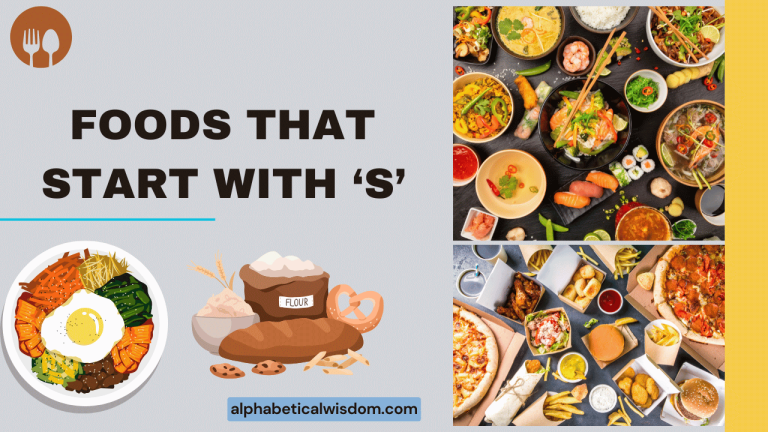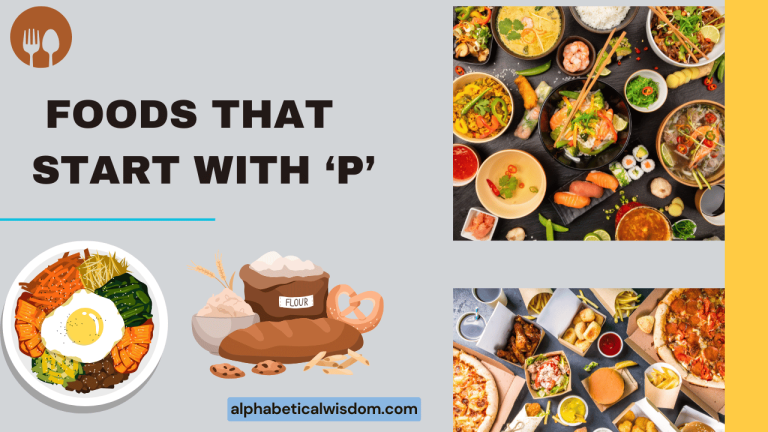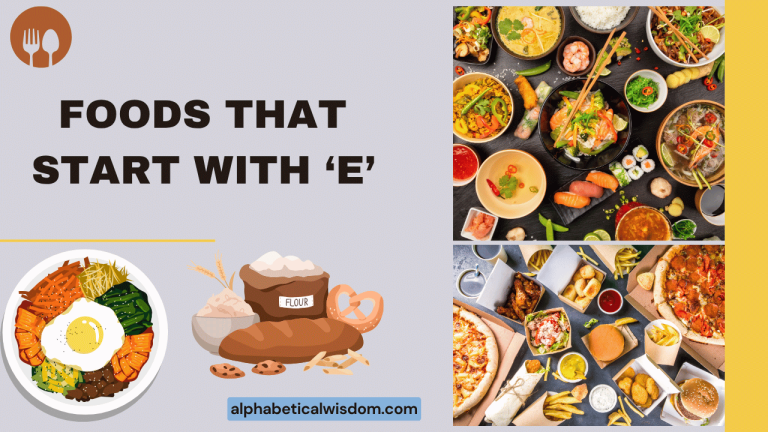Foods That Start With M: A Grammatical Exploration
Exploring foods that start with the letter “M” offers a unique lens through which to examine English grammar. This exploration helps to understand noun classifications (countable vs. uncountable), pluralization rules, and the use of articles (a, an, the) with different food items.
Mastering these concepts enhances vocabulary and improves sentence construction, making communication clearer and more effective. This guide is beneficial for English language learners of all levels, from beginners expanding their basic vocabulary to advanced speakers refining their grammatical accuracy.
Table of Contents
- Introduction
- Definition of Food Nouns
- Structural Breakdown: Noun Types
- Types and Categories of Food Nouns
- Examples of “M” Foods in Grammatical Context
- Usage Rules for Food Nouns
- Common Mistakes with Food Nouns
- Practice Exercises
- Advanced Topics
- Frequently Asked Questions
- Conclusion
Definition of Food Nouns
In English grammar, a noun is a word that represents a person, place, thing, or idea. Food nouns specifically refer to items that can be eaten and provide nourishment. These nouns can be classified as either countable or uncountable, a distinction that significantly impacts how they are used grammatically. Understanding this difference is crucial for accurate sentence construction and clear communication when discussing food.
Food nouns function as subjects, objects, complements, or appositives within sentences. They can be modified by adjectives and used with articles and quantifiers to provide more specific information about quantity and type.
The context in which a food noun is used often determines its grammatical behavior. For instance, a food noun typically considered uncountable may be used countably in specific situations, such as referring to different varieties or portions.
Structural Breakdown: Noun Types
The structure of English grammar dictates that nouns fall into various categories. Food nouns are primarily classified by their countability: countable or uncountable. Countable nouns are those that can be counted individually and have a plural form. Uncountable nouns, also known as mass nouns, cannot be counted individually and typically do not have a plural form. This distinction influences the articles and quantifiers that can be used with these nouns.
Additionally, food nouns can be further classified based on their specificity. Some food nouns are general terms (e.g., fruit, meat), while others are specific names of particular foods (e.g., mango, mackerel).
The level of specificity can affect the use of articles. For example, “I like fruit” uses the general term without an article, whereas “I ate a mango” uses the indefinite article “a” before a specific countable noun.
The interplay of countability and specificity shapes the grammatical structure surrounding food nouns in sentences.
Types and Categories of Food Nouns
Countable Nouns
Countable nouns are food items that can be counted as individual units. They have both singular and plural forms.
These nouns are often used with the indefinite articles “a” or “an” in the singular form and can be quantified with numbers or quantifiers like “many,” “few,” or “several” in the plural form. Examples of countable food nouns starting with “M” include muffins, macaroons, and marshmallows.
The ability to count these items directly influences their grammatical usage. For example, you can say “I ate three muffins” or “There are many macaroons on the plate.” The pluralization of these nouns is straightforward, typically involving the addition of “-s” or “-es” to the singular form.
Understanding this category is essential for forming grammatically correct sentences when discussing specific quantities of food.
Uncountable Nouns
Uncountable nouns, also known as mass nouns, represent food items that cannot be counted as individual units. These nouns typically do not have a plural form and are not used with indefinite articles “a” or “an.” Instead, they are often used with quantifiers like “much,” “little,” “some,” or with units of measurement (e.g., “a cup of,” “a slice of”).
Examples of uncountable food nouns starting with “M” include margarine, mayonnaise, and milk.
While uncountable nouns generally do not have a plural form, they can sometimes be used in a countable sense when referring to different types or varieties. For instance, you might say “We have three different mayonnaises” to indicate different flavors or brands of mayonnaise.
However, in most contexts, these nouns are treated as singular and require singular verb agreement. Recognizing uncountable nouns is crucial for avoiding common grammatical errors related to pluralization and article usage.
Examples of “M” Foods in Grammatical Context
The following tables provide examples of how foods starting with “M” are used grammatically. These examples illustrate the distinction between countable and uncountable nouns and demonstrate the correct use of articles and quantifiers.
Countable “M” Food Examples
This table showcases countable food nouns that start with “M,” demonstrating their usage in sentences with proper articles and pluralization.
| Food (Singular) | Food (Plural) | Example Sentence |
|---|---|---|
| Muffin | Muffins | I ate a muffin for breakfast. |
| Macaroon | Macaroons | She baked several macaroons for the party. |
| Marshmallow | Marshmallows | Children love to roast marshmallows over a campfire. |
| Mango | Mangos/Mangoes | He bought a ripe mango from the market. |
| Meatball | Meatballs | The spaghetti came with three large meatballs. |
| Melon | Melons | We sliced a melon to share at the picnic. |
| Mushroom | Mushrooms | The pizza was topped with fresh mushrooms. |
| Mint | Mints | She offered him a mint after the meal. |
| Mussel | Mussels | They ordered a plate of steamed mussels. |
| Meringue | Meringues | The dessert included delicate meringues. |
| Medlar | Medlars | He found a few ripe medlars in the orchard. |
| Mulberry | Mulberries | She picked a handful of mulberries from the tree. |
| Mandarin | Mandarins | He peeled a juicy mandarin for a snack. |
| Mincemeat Pie | Mincemeat Pies | They enjoyed warm mincemeat pies during the holidays. |
| Mooncake | Mooncakes | The family shared mooncakes during the Mid-Autumn Festival. |
| Maple Bar | Maple Bars | He grabbed a maple bar from the bakery. |
| Marzipan | Marzipans | The cake was decorated with colorful marzipans. |
| Mochi | Mochis | They sampled different flavors of mochis. |
| Macadamia Nut | Macadamia Nuts | She added a handful of macadamia nuts to the cookies. |
| Malted Milk Ball | Malted Milk Balls | He ate a bag of malted milk balls while watching the movie. |
| Madeleine | Madeleines | She enjoyed a cup of tea with madeleines. |
| Marmalade | Marmalades | They tried different brands of marmalades. |
| Masa | Masas | They prepared different types of masas for the tamales. |
| Matzo Ball | Matzo Balls | The soup contained fluffy matzo balls. |
| Meat Pie | Meat Pies | He ordered two meat pies for lunch. |
| Muffin Top | Muffin Tops | She ate a package of muffin tops. |
| Mushroom Cap | Mushroom Caps | They grilled a batch of mushroom caps. |
Uncountable “M” Food Examples
This table illustrates uncountable food nouns starting with “M,” showing their usage with appropriate quantifiers and units of measurement.
| Food | Example Sentence |
|---|---|
| Margarine | She spread some margarine on her toast. |
| Mayonnaise | He added a dollop of mayonnaise to his sandwich. |
| Milk | I drink a glass of milk every morning. |
| Mustard | She put a little mustard on the hot dog. |
| Maple Syrup | He poured some maple syrup on his pancakes. |
| Muesli | She eats muesli for breakfast every day. |
| Molasses | The recipe calls for a cup of molasses. |
| Miso | He added a spoonful of miso to the soup. |
| Marinade | She soaked the chicken in marinade overnight. |
| Mousse | They served chocolate mousse for dessert. |
| Marmalade (when referring to the substance in general) | I like marmalade on my toast. |
| Meat (in general) | He prefers lean meat in his diet. |
| Mascarpone | The tiramisu was made with mascarpone. |
| Malt | The beer is brewed with malt. |
| Marzipan (when referring to a mass of it) | She bought marzipan to decorate the cake. |
| Mint Sauce | He served lamb with mint sauce. |
| Maple Cream | She spread maple cream on her bagel. |
| Mushroom Soup | He ordered a bowl of mushroom soup. |
| Mashed Potatoes | She served mashed potatoes with gravy. |
| Mango Juice | He drank a glass of mango juice. |
| Mint Tea | She brewed a pot of mint tea. |
| Mochi Ice Cream | He bought several balls of mochi ice cream. |
| Mulberry Jam | She spread mulberry jam on her toast. |
| Mustard Greens | She cooked mustard greens with bacon. |
| Mushroom Gravy | He poured mushroom gravy over his steak. |
Mixed Countable/Uncountable “M” Food Examples
Some food nouns can be used as either countable or uncountable depending on the context. This table demonstrates how the same food noun can be used in different ways, affecting the choice of articles and quantifiers.
| Food | Countable Usage | Uncountable Usage |
|---|---|---|
| Marmalade | I bought three different marmalades from the store. (referring to specific jars or types) | I like marmalade on my toast. (referring to marmalade in general) |
| Meat | He ordered several different meats at the deli. (referring to specific cuts or types) | He prefers lean meat in his diet. (referring to meat in general) |
| Mochi Ice Cream | I bought three mochi ice creams. (referring to individual servings) | Mochi ice cream is a popular dessert. (referring to mochi ice cream in general) |
| Mushroom | I added three mushrooms to the sauce. (referring to individual mushrooms) | Mushroom is a great addition to pasta. (referring to mushroom in general) |
Usage Rules for Food Nouns
Understanding the rules governing the use of food nouns is essential for grammatical accuracy. These rules pertain to article usage, quantifier selection, and pluralization, all of which depend on whether the noun is countable or uncountable.
Using Articles with Food Nouns
The use of articles (a, an, the) with food nouns depends on the noun’s countability and specificity. Countable nouns in the singular form require the indefinite article “a” or “an” when referring to a non-specific item.
The choice between “a” and “an” depends on the sound of the following word: “a” is used before consonant sounds, and “an” is used before vowel sounds. Uncountable nouns generally do not take an indefinite article.
The definite article “the” is used with both countable and uncountable nouns when referring to a specific item or a previously mentioned item. For example, “I ate a muffin” (non-specific muffin) versus “The muffin I ate was delicious” (specific muffin).
Similarly, “I like milk” (milk in general) versus “The milk in the fridge is spoiled” (specific milk). Correct article usage enhances clarity and avoids ambiguity in sentences.
Using Quantifiers with Food Nouns
Quantifiers are words that express quantity. The choice of quantifier depends on whether the noun is countable or uncountable.
Countable nouns are used with quantifiers like “many,” “few,” “several,” and numbers. Uncountable nouns are used with quantifiers like “much,” “little,” “some,” and expressions like “a lot of” and “a bit of.”
For example, you would say “I ate many muffins” (countable) but “I drank much milk” (uncountable). The quantifier “some” can be used with both countable and uncountable nouns: “I ate some muffins” and “I drank some milk.” Using the correct quantifier ensures that the quantity is expressed accurately and grammatically.
Pluralization of Countable Food Nouns
Countable food nouns follow standard pluralization rules. Most nouns are made plural by adding “-s” to the singular form (e.g., muffin → muffins, melon → melons).
Nouns ending in -s, -x, -ch, or -sh typically add “-es” (e.g., marsh → marshes, lunch → lunches). Some nouns ending in -o also add “-es” (e.g., mango → mangoes), although “-s” is also acceptable in some cases (e.g., mango → mangos).
Irregular plural forms exist but are less common with food nouns. Mastering these pluralization rules enables accurate expression of quantity and avoids grammatical errors in writing and speech.
Consistent and correct pluralization enhances the clarity and professionalism of communication.
Common Mistakes with Food Nouns
Several common mistakes arise when using food nouns, particularly regarding countability, article usage, and quantifier selection. Recognizing these errors and understanding how to correct them is crucial for improving grammatical accuracy.
Incorrect: “I ate a milk.”
Correct: “I drank some milk.” (Milk is uncountable and does not take the indefinite article “a.”)
Incorrect: “I want many mayonnaise.”
Correct: “I want a lot of mayonnaise.” (Mayonnaise is uncountable and requires a quantifier suitable for mass nouns.)
Incorrect: “There are much muffins on the plate.”
Correct: “There are many muffins on the plate.” (Muffins are countable and require the quantifier “many.”)
Incorrect: “I bought a margarine.”
Correct: “I bought some margarine.” (Margarine is uncountable and does not take the indefinite article “a.”)
Incorrect: “I like the milks.”
Correct: “I like milk.” (Milk in general should not be pluralized.)
These examples illustrate frequent errors and highlight the importance of understanding the grammatical properties of food nouns. Paying attention to countability and applying the appropriate rules ensures clear and accurate communication.
Practice Exercises
These exercises will help you practice using food nouns correctly. Each exercise focuses on a different aspect of food noun usage, including countability, article usage, and quantifier selection.
Complete each exercise and check your answers to reinforce your understanding.
Exercise 1: Countable or Uncountable?
Identify whether the following food nouns are countable (C) or uncountable (U).
| Food | Countable (C) or Uncountable (U) | Answer |
|---|---|---|
| Muffin | C | |
| Mayonnaise | U | |
| Mango | C | |
| Milk | U | |
| Mushroom | C | |
| Margarine | U | |
| Meatball | C | |
| Mustard | U | |
| Melon | C | |
| Muesli | U |
Exercise 2: Article Usage
Fill in the blanks with the appropriate article (a, an, the) or no article (Ø).
| Sentence | Article | Answer |
|---|---|---|
| I ate _____ muffin for breakfast. | a | |
| _____ milk in the fridge is spoiled. | The | |
| She added _____ mango to the smoothie. | a | |
| I like _____ mayonnaise on my sandwich. | Ø | |
| He picked _____ mushroom from the garden. | a | |
| She spread ____ margarine on her toast. | Ø | |
| They ordered _____ meatballs for dinner. | Ø | |
| He put ____ mustard on his hotdog. | some | |
| We sliced ____ melon for the picnic. | a | |
| I eat ____ muesli every morning. | Ø |
Exercise 3: Quantifier Usage
Choose the correct quantifier (much, many, some) to complete the sentences.
| Sentence | Quantifier | Answer |
|---|---|---|
| I don’t have _____ muffins left. | many | |
| She doesn’t drink _____ milk. | much | |
| He added _____ mangoes to the salad. | some | |
| There isn’t _____ mayonnaise in the jar. | much | |
| We found _____ mushrooms in the forest. | many | |
| She used _____ margarine in the recipe. | some | |
| They ate _____ meatballs for lunch. | many | |
| He doesn’t like _____ mustard. | much | |
| We bought _____ melons at the store. | some | |
| I added ____ muesli to the yogurt. | some |
Advanced Topics
For advanced learners, exploring collective nouns and idiomatic expressions related to food nouns can further enhance their understanding and fluency.
Collective Nouns for Food
Collective nouns refer to a group of items as a single unit. While not commonly used with individual food items starting with “M,” collective nouns can be used in broader contexts.
For example, a “mountain” of marshmallows, a “batch” of muffins, or a “selection” of marmalades. These collective nouns provide a way to describe groups of food items concisely.
Understanding collective nouns helps in forming more descriptive and nuanced sentences. While the specific collective nouns used may vary depending on the context, recognizing their function allows for more sophisticated language use.
For instance, instead of saying “There are many muffins,” you could say “There is a batch of muffins.”
Idiomatic Expressions with Food
Idiomatic expressions are phrases whose meaning cannot be understood from the literal meanings of the individual words. Several idiomatic expressions involve food, though fewer specifically involve foods starting with “M.” However, understanding food-related idioms enhances comprehension of figurative language and cultural nuances.
Examples of food-related idioms include “to eat humble pie” (to admit one’s mistake and apologize), “to have a sweet tooth” (to enjoy sugary foods), and “to be full of beans” (to be energetic). While these examples do not directly involve foods starting with “M,” they illustrate the broader category of food-related idioms and their role in English language and culture.
Recognizing and understanding these expressions contributes to more nuanced and effective communication.
Frequently Asked Questions
This section addresses common questions about using food nouns, covering various aspects such as countability, article usage, and quantifier selection.
- Q: How do I know if a food noun is countable or uncountable?
A: Countable nouns can be counted individually and have a plural form (e.g., muffin, muffins). Uncountable nouns cannot be counted individually and generally do not have a plural form (e.g., milk, mayonnaise). Consider whether you can put a number before the noun without changing its form.
- Q: Can an uncountable food noun ever be used countably?
A: Yes, in certain contexts. For example, when referring to different types or varieties of an uncountable noun, it can be used countably. “We have three different mayonnaises” refers to different flavors or brands.
- Q: When should I use “a” versus “an” before a food noun?
A: Use “a” before a consonant sound and “an” before a vowel sound. For example, “a muffin” but “an apple.” The sound, not the letter, determines the choice.
- Q: Can I use “the” with uncountable food nouns?
A: Yes, when referring to a specific instance of the uncountable noun. “The milk in the fridge is spoiled” refers to a particular quantity of milk, not milk in general.
- Q: What quantifiers can I use with countable food nouns?
A: Use quantifiers like “many,” “few,” “several,” and numbers with countable food nouns. “I ate many muffins” or “I bought three mangoes.”
- Q: What quantifiers can I use with uncountable food nouns?
A: Use quantifiers like “much,” “little,” “some,” “a lot of,” and “a bit of” with uncountable food nouns. “I drank much milk” or “I added a bit of mayonnaise.”
- Q: How do I pluralize food nouns ending in “-o”?
A: Most food nouns ending in “-o” add “-s” (e.g., melon → melons). Some add “-es” (e.g., mango → mangoes), although both forms may be acceptable in some cases.
- Q: What should I do if I’m unsure whether a food noun is countable or uncountable?
A: Consult a dictionary or grammar guide. Pay attention to how the noun is used in context. If you can easily count it as individual units, it is likely countable.
- Q: How can I improve my understanding of food noun usage?
A: Practice using food nouns in sentences, read widely, and pay attention to how native speakers use them. Complete exercises and seek feedback on your writing.
- Q: Are there any exceptions to the rules of food noun usage?
A: Yes, language is dynamic, and exceptions exist. Context often plays a crucial role. Continued exposure and practice will help you navigate these nuances.
Conclusion
Understanding the grammatical properties of food nouns, especially those starting with the letter “M,” is a valuable aspect of mastering English grammar. By distinguishing between countable and uncountable nouns, using articles and quantifiers correctly, and avoiding common mistakes, learners can significantly improve their accuracy and clarity in communication.
This knowledge extends beyond simple vocabulary acquisition, enhancing overall language proficiency.
Remember to practice regularly, consult resources when unsure, and pay attention to the nuances of language use in different contexts. With consistent effort, you can confidently navigate the complexities of food nouns and express yourself effectively in English.
Continued learning and application are key to achieving fluency and grammatical excellence.
